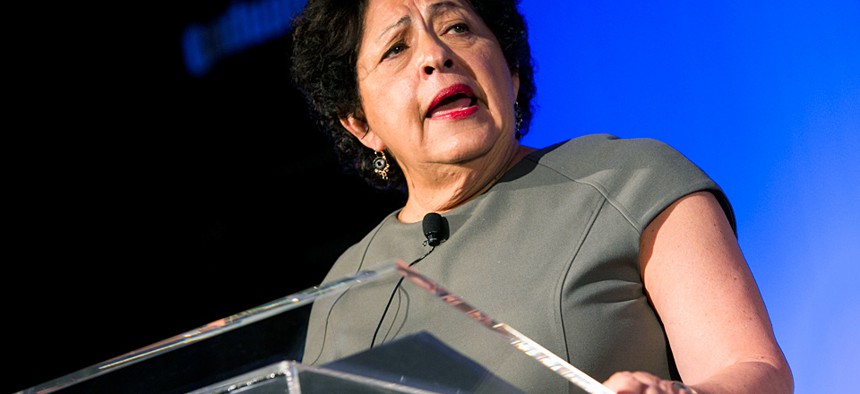
OPM Director Katherine Archuleta has said the agency will be ready to accept applications Nov. 6. Kristoffer Tripplaar
Can You Apply for Phased Retirement This Fall? It Depends on Your Agency
OPM is accepting applications beginning in November, but some agencies are telling employees they can’t apply that soon.
Many federal employees interested in phased retirement are going to have to wait to apply until 2015 at the earliest, according to reports from feds in multiple agencies.
The Office of Personnel Management issued final rules on partial retirement in August, more than two years after Congress passed the law, and the agency said eligible federal employees can submit applications starting on Nov. 6. But the reality is most feds will have a longer wait because individual agencies have to devise their own plans for implementing phased retirement that meet the needs of their missions as well as collective bargaining agreements.
The Homeland Security Department and Social Security Administration are two agencies that have sent employees official emails saying that they cannot submit applications for phased retirement in November because management needs more time to craft implementation plans. An Aug. 15 email to SSA’s Chicago region managers from human resources said that if the agency decides to offer phased retirement, it won’t do so until 2015 or later.
“It has been reported in the press that OPM can begin accepting applications for this program on Nov. 6, 2014,” the email stated. “We believe that date is extremely premature for soliciting applications from SSA employees. The regulations require agencies to take many preparatory steps, including fulfilling their labor obligations, before a program can actually be implemented.”
An SSA employee said she’s been waiting two years for phased retirement to become available, and is frustrated by the additional delay. “I want to retire but would love to participate in phased retirement!” she wrote by email.
Amy Reeder, a management program analyst at Homeland Security’s Citizenship and Immigration Services, said employees at DHS received a similar message, stating that the department had to come up with its own plan before eligible workers could apply for phased retirement. Reeder said the email didn’t specify when that would happen. Reeder, who has worked for the federal government at several agencies for 36 years, plans on fully retiring in December 2015, and feared she might miss the window for partial retirement depending on when DHS rolls out its program. “If it comes out six months before I retire, I’m not going to [apply]. It’s not worth the effort,” she said. “I thought it [phased retirement] was going to happen two years ago, and I’m very disappointed.”
A scientist with the Army Research Lab at White Sands Missile Range in New Mexico said he’s looking to fully retire in about four years, and would like to take advantage of phased retirement. He asked his HR shop, who told him they were waiting for guidance from the Army Department. “My guess is that I will eventually apply for it, I just don’t know when,” he said. The lab’s management has tried to prepare for a retirement wave, and that there’s interest in offering phased retirement to employees, he added. But, as with other agencies, the timing is uncertain. “There’s a good chance we could potentially lose one-third to one-half of our employees to retirement in the next five to eight years, and that’s going to be a huge hit,” he said. Management, he said, “sees what’s coming up the road for retirement. They are approaching this as positively as they can.”
Phased, or partial retirement, is another tool federal agencies have to keep seasoned employees who are eligible for retirement on the job longer to train and mentor their successors. The benefit allows eligible feds to work 20 hours per week, receiving half their pay as well as half their retirement annuity. Those employees who enter phased retirement must devote at least 20 percent of their work time, or about 8 hours a pay period, to mentoring other employees, ideally for those who take over for them when they fully retire.
Agencies have broad discretion in deciding how to implement phased retirement, including deciding which jobs are eligible for it, determining mentoring activities and deciding how long an employee can remain partially retired. When eligible employees can apply for the opportunity will depend on how quickly their individual agencies can figure out a framework for offering phased retirement.
An OPM spokeswoman said the agency will be ready to accept applications on Nov. 6, as Director Katherine Archuleta said when the final rules were published. “It’s up to the individual agencies to decide on when they are able and willing to submit PR applications,” the spokeswoman said. “As with any other change, agencies must prepare their own processes for accepting and processing the applications and determine who they will afford the PR opportunity to.”
NEXT STORY: Phased Retirement: Case Studies







